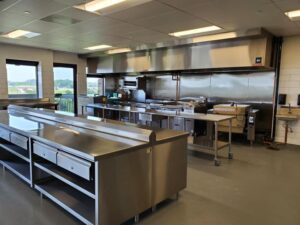Have you ever wondered why some commercial stainless steel work tables shine like new for years while others quickly lose their luster? You’re about to uncover that selecting the right grade of stainless steel for your commercial kitchen isn’t just about aesthetics—it’s a critical investment decision that’ll impact your daily operations and bottom line. While the initial cost difference between 304 and 430-grade tables might tempt you to economize, understanding the long-term implications of your choice can mean the difference between a surface that withstands years of rigorous use and one that deteriorates prematurely. Let’s explore what separates a smart investment from an expensive mistake.
Understanding Stainless Steel Grades
In the food service industry, stainless steel grades play a vital role in determining the durability and performance of work tables. When selecting a work table, you must understand the fundamental differences between the two most common grades: 304 and 430 stainless steel. These grades differ in crystalline structure, directly impacting their performance characteristics.

304-grade stainless steel offers superior corrosion resistance, making it the best choice for humid kitchen environments with frequent moisture exposure. This grade excels in sanitization requirements and maintains its integrity even with repeated cleaning. It’s particularly well-suited for areas where acidic ingredients or harsh cleaning chemicals are handled.
In contrast, the 430 grade provides adequate performance for less demanding environments but has limitations. While it’s still stainless steel, you’ll notice it’s more susceptible to rusting over time, especially in high-moisture conditions. When resilience is pivotal, and your kitchen experiences heavy use or frequent exposure to moisture, you’ll want to invest in 304-grade tables to guarantee long-term dependability and uphold proper food safety standards.
Benefits of Commercial Kitchen Tables
For commercial kitchens, stainless steel work tables deliver critical benefits that directly impact daily operations and food safety protocols. The 304-grade stainless steel construction guarantees a corrosion-resistant surface that withstands frequent cleaning and sanitizing. At the same time, the grained finish reduces glare and provides an ergonomic design for your staff’s comfort during food prep tasks.
These tables offer versatile placement options and fit seamlessly into your kitchen’s workflow. The open base design supports efficient organization by accommodating large food bins underneath, maximizing your available space.
When you choose 14-gauge stainless steel surfaces, you’re investing in an extended lifespan and superior durability that can handle intense butchering and heavy-duty food preparation without showing wear.
The customization options with stainless steel tables let you adapt the workspace to your needs. You can select different heights, sizes, and configurations to optimize your kitchen’s layout. This flexibility, combined with the material’s inherent strength and easy-maintenance properties, makes stainless steel tables a critical investment for any commercial kitchen seeking to improve operational efficiency and maintain stringent hygiene standards.
Common Table Construction Methods
When selecting stainless steel work tables, you’ll encounter two primary construction methods: spot and continuous welding. While spot welding creates individual connection points, continuous welding techniques provide superior frame reinforcement and enhanced structural integrity. Continuously welded tables offer better resistance to heavy loads and frequent movement.
Some manufacturers offer bolted construction options for modular design flexibility. This approach allows you to reconfigure or disassemble the table as your kitchen layout evolves. When examining tabletop attachments, you’ll notice two main methods: welded surfaces that create a seamless finish, ideal for strict hygiene requirements, and mechanical fasteners that enable easier maintenance and replacement.
Undershelves typically combine welding and mechanical fasteners to ensure stability and adaptability. For mobility solutions, caster installation methods vary between threaded inserts and welded mounting plates. You’ll want to choose based on your specific needs—threaded inserts offer easier caster replacement, while welded plates provide maximum stability. Consider your kitchen’s workflow requirements and cleaning protocols when deciding between these construction methods.
Gauge and Material Thickness
Understanding steel gauge specifications is crucial for selecting the right work table thickness. When evaluating your durability concerns, remember that lower gauge numbers indicate thicker steel, directly impacting your table’s weight load capacity and long-term performance.

For basic food prep and light-duty tasks, 18-gauge tables (0.0478 inches) offer sufficient table frame stability while keeping material cost considerations manageable. If you’re operating a busier kitchen with moderate usage, consider upgrading to 16-gauge tables (0.0598 inches), which provide enhanced durability without a significant price premium. The thicker steel also allows for more robust tabletop edge profiles, improving aesthetics and safety.
You’ll want to invest in 14-gauge tables (0.0747 inches) for heavy-duty applications like meat processing or high-volume prep work. While they’re the most expensive option, their superior strength and durability make them the most cost-effective choice for demanding environments. The extra thickness guarantees maximum frame stability and supports heavier loads without compromising structural integrity, even under constant use. Your choice should align with your kitchen’s workload requirements and budget constraints.
Surface Finish Options
Exceeding the steel gauge selection, your stainless steel work table’s surface finish directly affects its functionality and maintenance requirements. When choosing a surface finish, you must evaluate your kitchen operations and cleaning protocols to guarantee optimal performance.
The most prevalent option in commercial kitchens is a brushed finish with a single-direction grain pattern. This satin sheen balances durability and aesthetics, masking minor scratches and daily wear. This finish offers superior scratch resistance compared to a mirror polish, which, while visually striking, requires more attention to preserve its reflective appearance.
Consider a bead-blasted surface for specialized applications that creates a uniform, matte appearance. This finish excels in high-traffic areas requiring enhanced grip and reduced light reflection. Textured patterns can provide additional slip resistance and help conceal surface imperfections. When selecting your finish, prioritize durability and maintenance requirements over aesthetic appeal to guarantee your work table maintains its functionality throughout years of commercial use.
Base Storage Configurations
Base storage configurations represent a critical design element that greatly impacts your kitchen’s operational efficiency and storage capacity. When selecting your table’s base design, you must evaluate your specific storage requirements and operational workflow patterns.

Open base designs, compatible with various table leg options, provide maximum flexibility for storing larger items and enable easy cleaning access. Adding casters to these configurations enhances mobility, making it simple to relocate your work surface as needed.
If you prioritize organized storage, shelved bases offer structured space for smaller equipment and supplies, though they’ll require more thorough cleaning protocols. Pass-through designs complement your work surface accessories by allowing access from both sides, ideal for high-volume prep areas where staff mobility is indispensable.
Corner-style configurations maximize available space for custom sizing while maintaining storage accessibility. Consider edge profile choices that complement your base design—for instance, marine edges work well with solid bases to prevent liquid runoff.
Solid base designs provide a clean appearance if you have limited space, but remember that they restrict under-table storage capacity.
Essential Size and Space Planning
Precise measurement and planning are the foundation for selecting the right stainless steel work table dimensions. You’ll need to evaluate your kitchen’s layout and intended usage to determine the optimum table height, typically 30 to 36 inches, to guarantee an ergonomic design that minimizes worker strain during food preparation tasks.
When implementing space optimization strategies, consider that rectangular or square tables offer the most versatile configurations, with 14 to 108 inches widths. For prep-intensive operations, you’ll opt for deeper tables of 24 to 30 inches, while lighter tasks can be accomplished efficiently on 12 to 18-inch depth surfaces. These dimensions directly impact your workflow considerations and overall kitchen efficiency.
Don’t overlook clearance requirements when positioning your work table. You must maintain adequate space for staff movement and equipment access around all sides. This planning step is indispensable for meeting safety standards and guaranteeing smooth operations. By carefully calculating your space needs and accounting for workflow patterns, you can select table dimensions that maximize your kitchen’s productivity while maintaining proper circulation paths.
Maintenance and Cleaning Requirements
Your stainless steel work tables demand a rigorous cleaning protocol that aligns with commercial kitchen sanitation standards for best performance and longevity. Your daily cleaning regimen should include wiping down surfaces with non-abrasive cleaners after each use, guaranteeing thorough removal of food residue and spills. Don’t let food particles harden, as they can compromise sanitation and surface integrity.
Implement all-encompassing disinfection protocols that include sanitizing solutions approved for food-service environments. After cleaning, dry surfaces thoroughly and apply appropriate polishing techniques to prevent corrosion.
Spill cleanup procedures should address immediate containment and thorough sanitization to maintain hygiene standards and prevent staining.
Develop a table inspection checklist that you’ll use regularly to identify potential issues such as loose bolts, surface scratches, or signs of wear. This proactive maintenance approach helps you address minor problems before they escalate into major repairs. Document all maintenance activities and keep records of cleaning procedures to ensure consistency in your sanitation practices. When you notice any damage or unusual wear patterns, address them promptly to protect your investment and maintain food safety compliance.
Choosing the Right Commercial Stainless Steel Work Tables for Your Kitchen’s Needs
Selecting the right stainless steel work tables for your commercial kitchen is more than a practical decision—it’s a strategic investment in efficiency, safety, and durability. Choosing 304-grade stainless steel for high-moisture and high-use areas ensures your kitchen operations remain seamless and sanitary for years. 430-grade stainless steel offers a cost-effective solution for lighter demands, but understanding your kitchen’s specific requirements is key to making the right choice.
For over 50 years, All Southern Fabricators has been a trusted partner in the food service industry, providing expertly crafted stainless steel solutions tailored to businesses of all sizes’ unique needs. Whether you need custom work tables, innovative designs, or long-lasting equipment, ASF delivers unparalleled quality and customer service.
Contact All Southern Fabricators today to learn how their custom stainless steel solutions can transform your commercial kitchen. Call (800) 878-2732 or visit allsouthern.com to explore their range of products and services. Don’t settle for less—partner with experts committed to building solutions that stand the test of time.

